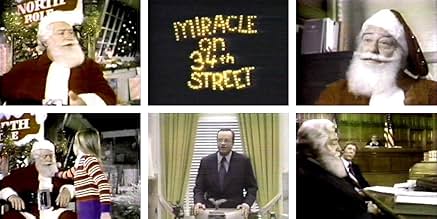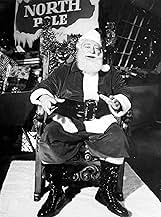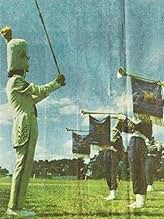A department store Santa tries to convince a little girl who doesn't believe in Santa Claus that he is Santa Claus, and winds up going on trial to prove who he is.A department store Santa tries to convince a little girl who doesn't believe in Santa Claus that he is Santa Claus, and winds up going on trial to prove who he is.A department store Santa tries to convince a little girl who doesn't believe in Santa Claus that he is Santa Claus, and winds up going on trial to prove who he is.
- Director
- Writers
- Stars
Gloria LeRoy
- Mother #1
- (as Gloria Leroy)
- Director
- Writers
- All cast & crew
- Production, box office & more at IMDbPro
Featured reviews
First let me begin by saying that nothing exceeds the original black & white 1947 version of MIRACLE ON 34TH STREET. It is rare when a movie remake is better than the original. The 1973 version of this film by no means is better than the 47 version, for that matter nor is the 94 version. In my opinion the 94 version is the worst but I'll not comment on that here.
I feel that the 74 version does bring some good things to the table. I find the color here better than the Ted Turner coloring of the 47 version. I believe that movies filmed in black & white should stay in black & white. Turner does an injustice to movie making with his colorization process. I also like the selection of the actors for this film. Both Alexander and Hartman give good performances and come off across as ordinary looking and yet are an attractive couple. Davis did seem to overact a bit in the role of the lead child but she is tolerable.
When looking at a film I like to be able to identify what era it was made in. Both the 47 and 73 are identifiable by the autos, clothes, toys and parade floats & balloons. While not alive in 47 I was a kid in 73 and it's nice to watch a film and be reminded of images from my own youth.
So, while it is true that the 73 version does not do better than the 47 version it does not flop either.
I feel that the 74 version does bring some good things to the table. I find the color here better than the Ted Turner coloring of the 47 version. I believe that movies filmed in black & white should stay in black & white. Turner does an injustice to movie making with his colorization process. I also like the selection of the actors for this film. Both Alexander and Hartman give good performances and come off across as ordinary looking and yet are an attractive couple. Davis did seem to overact a bit in the role of the lead child but she is tolerable.
When looking at a film I like to be able to identify what era it was made in. Both the 47 and 73 are identifiable by the autos, clothes, toys and parade floats & balloons. While not alive in 47 I was a kid in 73 and it's nice to watch a film and be reminded of images from my own youth.
So, while it is true that the 73 version does not do better than the 47 version it does not flop either.
Mirricle is my favorite Christmas movie, the 1974 version i think is my least favorite but i have only seen it once a very long time ago. I just wish there was a set I could buy with all the versions on it, because sometimes I wish I could watch them all back to back. Just a thought corporate America PUT OUT A BOXED SET!!!!!!!! All of the versions have their strong suits. The original is the most widely recognized and beautifully written and I believe most everyones favorite, but I have never even seen the fifties TV version, and I would like that opportunity. The 74 version has some nostalgia for the people who saw it when they were little, and the most recent version is easier for small children to identify with. It would even be nice if they could have a version of the Broadway play but I doubt there are any copies of it running around.
10ronyo9
I worked on this made-for-TV-movie as a set dresser back in 1973. It was my first job as a returning Vietnam war era veteran. The art director was a woman named Jan Scott who offered me more work as Set dresser but I chose to attend college on the GI bill as an art major, with the eventual goal of teaching art, though I did continue to work on a few more film projects on occasion.
What is very noteworthy about this production was that the majority of the crew had just finished Martin Scorcese's "Mean Streets" and many of the locations used to film Mean Streets, most notably the Green Hotel in Pasedena, were used to film Miracle. In retrospect it's funny to think about how so many who had worked with Scorsese all thought that while he was a fairly good director, he was such a neurotic quirky sort that he probably wouldn't last long in the business and also no one seemed to think much of Mean Streets as a finished product. Most did, however, have a high opinion of De Niro's acting ability.
Fielder Cook the director, was an early Hollywood television pioneer having directed episodes of Playhouse 90 and many other early TV productions. He was also quite the colorful character and well-liked by the crew. The two other people who impressed me were actors Roddy McDowell and Sebastion Cabot. Cabot, for his acting ability and McDowell Because after the project was wrapped he personally and quite sincerely thanked every crew member for a job well done.
I was so impressed by Cabot's portrayal of Kris Kringle that as a college student, during Christmas vacation I got a job as a Department store Santa at a somewhat upscale large retail establishment in L.A. and played the "role" of Santa Claus much the way Cabot did and put on makeup for every "performance".
On one occasion where there was a crowd of people waiting to bring their children up to sit on my lap and be photographed by my attractive young female "elves" I noticed a distinguished looking and portly white-haired older gentleman standing in the back of the crowd watching who I swear to God, MUST have been the Real Santa.
What is very noteworthy about this production was that the majority of the crew had just finished Martin Scorcese's "Mean Streets" and many of the locations used to film Mean Streets, most notably the Green Hotel in Pasedena, were used to film Miracle. In retrospect it's funny to think about how so many who had worked with Scorsese all thought that while he was a fairly good director, he was such a neurotic quirky sort that he probably wouldn't last long in the business and also no one seemed to think much of Mean Streets as a finished product. Most did, however, have a high opinion of De Niro's acting ability.
Fielder Cook the director, was an early Hollywood television pioneer having directed episodes of Playhouse 90 and many other early TV productions. He was also quite the colorful character and well-liked by the crew. The two other people who impressed me were actors Roddy McDowell and Sebastion Cabot. Cabot, for his acting ability and McDowell Because after the project was wrapped he personally and quite sincerely thanked every crew member for a job well done.
I was so impressed by Cabot's portrayal of Kris Kringle that as a college student, during Christmas vacation I got a job as a Department store Santa at a somewhat upscale large retail establishment in L.A. and played the "role" of Santa Claus much the way Cabot did and put on makeup for every "performance".
On one occasion where there was a crowd of people waiting to bring their children up to sit on my lap and be photographed by my attractive young female "elves" I noticed a distinguished looking and portly white-haired older gentleman standing in the back of the crowd watching who I swear to God, MUST have been the Real Santa.
Personally, I have seen all three versions of this film, and while I understand why older generations and purists stand by the original as the best one, that doesn't mean that people can't still enjoy this version. For a made-for-TV version, it has a wonderful cast, with Sebastian Cabot being the highlight. I thought the way the court case was handled was better here than in the 1994 version, and having grown up with color all of my life (and having been born only 2 years before this version originally came out), I still claim this one as my favorite. That is not to say that the original or 1994 versions aren't good--I think they all have a place for those who enjoy them. I just think that this story--like many others--is a generational one, and everyone is going to have at least a little nostalgia for the one from their generation. My only wish, which so far has gone unfulfilled, is that someone will eventually put this version out on DVD and Blu-Ray so that those of us who enjoy it can watch it again. The 1947 and 1994 versions' fans have access to their movies--why can't we? I think the reviewer who offered the option of a box set including all versions of this movie has a wonderful idea--that way, everyone's happy, and each is different enough from the others that you can watch them all and enjoy them.
I thought the Thomas Mitchell version as OK as we'll, while Richard Attenborough's left a bitter taste in my mouth. What stood out was that it's set up blended so well into the 70's era. I confess, I always thought of David Hartman as a newsman, but here I realize he wasn't a bad actor at all. Cabot's Santa? Loved him! Convincingly kind and gentle, and showed brilliant Santa magic.
In some ways it does feel like you'd get lost following this if you didn't already know the story, because you don't get a lot to tell you just what the characters as set up are all about, and you don't get hardly any exposition of Karen Walker as an unbeliever, but familiarity saves it. As well, I feel like i wouldn't like it as much if not for wanting some reprieve from the forced resolution I got out of the Attenborough version. The Post Office miracle doesn't feel as brilliant, but still different enough to feel fresh, a nd believable enough to appreciate as a miracle.
I won't put as much diligence into making this a Christmas season must-see, but I'll definitely get to a point where it feels like another go is in order. Not a bad version at all.
In some ways it does feel like you'd get lost following this if you didn't already know the story, because you don't get a lot to tell you just what the characters as set up are all about, and you don't get hardly any exposition of Karen Walker as an unbeliever, but familiarity saves it. As well, I feel like i wouldn't like it as much if not for wanting some reprieve from the forced resolution I got out of the Attenborough version. The Post Office miracle doesn't feel as brilliant, but still different enough to feel fresh, a nd believable enough to appreciate as a miracle.
I won't put as much diligence into making this a Christmas season must-see, but I'll definitely get to a point where it feels like another go is in order. Not a bad version at all.
Did you know
- TriviaOriginally, this TV movie was offered to Natalie Wood and Robert Wagner, with Wood's daughter Natasha Gregson Wagner to play Susan. However, Wood, a former child star herself, who portrayed Susan in the 1947 classic original Le Miracle sur la 34ème rue (1947), declined on the grounds that Natasha was too young, and she wanted her to have as normal a childhood as possible.
- GoofsIn many scenes, green leaves are seen on the trees. This movie was clearly not filmed in November/December.
- ConnectionsReferenced in Mystery Science Theater 3000: Santa Claus Conquers the Martians (1991)
Details
- Release date
- Country of origin
- Language
- Also known as
- Milagro en la calle 34
- Filming locations
- Production companies
- See more company credits at IMDbPro
- Runtime
- 1h 40m(100 min)
- Color
- Aspect ratio
- 1.33 : 1
Contribute to this page
Suggest an edit or add missing content






























